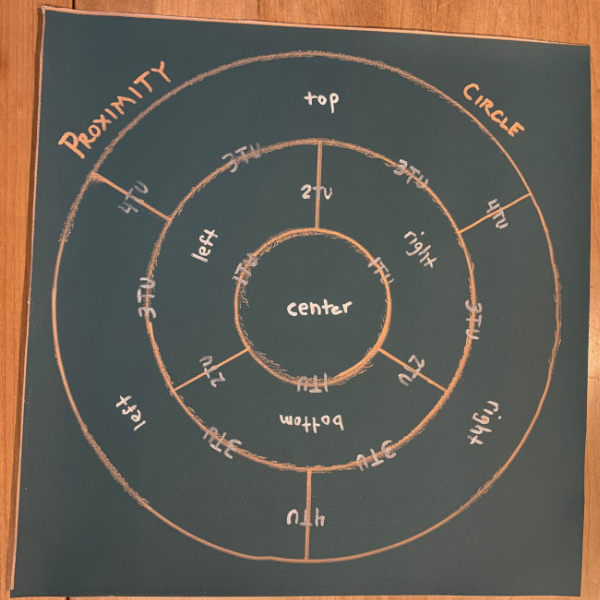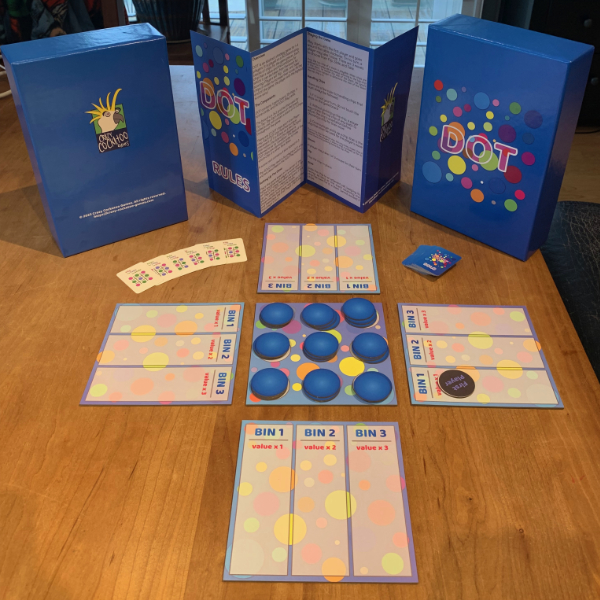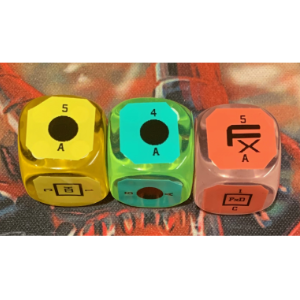
The Protospiel Track
DunDraCon 2024 was held this year from February 16-19 at the Santa Clara Marriott Hotel. DunDraCon is local to our headquarters so we didn't need to spend money on a hotel room. This year, DunDraCon had a special Protospiel track where game designers could playtest their games, and where attendees were rewarded for playtesting with raffle tickets for games and prizes - it was a win-win for everyone!
We were lucky to have some great playtesters spend time with us. Some of them kept coming back to try each of our games and give them a go a few times. We had a great time and received a lot of positive feedback on our games (as well as some great constructive critisms). We also got to playtest a lot of other games and meet other game designers; there are some incredible designers out there.
We only anticipated being able to playtest two of our games, but we were lucky enough to have a third ready for playtesting as well.
Playtesting DOT
Our first game that we playtested was DOT. DOT is an abstract strategy game somwhere between chess and checkers. The DOT tag line is 'Just enough strategy, a sprinkle of luck… and DOTs'.
DOT is played on a 3x3 grid similar to a Tic-Tac-Toe board. There are stacks of chips in each cell of the grid. Each chip face has a small 3x3 grid with certain cells filled with DOTs representing face-up chips on the board. When a chip is flipped, if its face matches the board, the chip can be taken for points. As with chess, DOT has subtle strategies, but the luck factor sets it apart from chess and allows for surprise victories if players aren't careful.
DOT was pretty polished and we were looking for feedback on how to fix some of the rough edges. Everyone that played it thought it was a win and hit the right balance between strategy and luck. It also plays much faster than chess while scratching the same itch.
Playtesting FxRPG
FxRPG is a tabletop role-playing game (TTRPG) that we've been working on for quite some time. We've been playtesting it with our friends and family, but this was the first time we were able to playtest it with exernal playtesters. The FxRPG rules are setting agnostic, and can cover many different genres and settings.
FxRPG centers around the Character and their Traits, Equipment, and Specializations. Each Trait, piece of Equipment, and Specialization is represented by a card that is placed on the Character Mat. Furthermore, Conditions, which are usually representative of damage, are also represented by cards on the Character Mat. In this way, the Character Mat is a very visual representation of the Character and their current state.
Action resolution uses a dice pool of up to 3 different custom six-sided dice that determine action success, possibly scaling the action into something more, or consequences that the Character must deal with.
The One-Shot
For the playtest, I prepared a one-shot loosely based on concepts found in The Dispatcher by John Scalzi.
This is the introduction that I read to the players:
So basically, the Characters were tasked with clearing a room of baddies. One of the ways FxRPG sets itself apart from other RPGs is in the use of the Proximity Circle for close engagements. The Circle tracks both distance and terrain difficulty, and simplifies weapon ranges and movement, all while maintaining a high level of tactical depth.
Using this one-shot, we playtested the use of the Proximity Circle and the Character Mat and cards - and it went GREAT. Everyone had a good time, and gave great feedback. The action resolution with the custom dice also turned out very fun and lead to a lot of interesting outcomes.
Along with FxRPG, we are creating our first setting called Explorers of StarSea™ (EOSS). It is basically Treasure Island in space - similar to Disney's Treasure Planet on the surface, but beneath, much different. We are currently generating a lot of content for EOSS that GMs can leverage for their RPGs, especially FxRPG.
Playtesting Circuit
The third game we playtested was Circuit. Circuit is a bidding and dice placement game set in our second setting called Urban Rising; think Blade Runner but more optimistic. (Urban Rising is not yet public though we have written quite a bit of material.)
In Urban Rising, each Character has a Circuit Board, which is a multi-purpose ID that has Ports for holding Cubes which contain valuable data from information to Creds.
In the game of Circuit, players bid with their Cubes (which are represented by six-sided dice) and the winner of the bidding gets to place one of their Cubes in one of the empty Ports on the Circuit Board in play. There is a strategy to placing Cubes because not all Cubes nor Circuit Boards are equal and Cubes can get bumpbed from the Circuit Board. When all Ports on the Circuit Board are filled, the round ends and each player earns 1 Cred for each Cube on the Circuit Board. A new round with a new Circuit Board begins until a number of Circuit Boards have been completed equal to the number of players. The player with the most Creds at the end of the game wins.
At first, one of the playtesters felt like Circuit was a simple and lopsided game, with little strategy and too much luck (due to the rolling of the dice involved in bidding). However, after playing for a few rounds, the playtester changed their tune and really fell in love with the game. There is a lot of strategy to both the bidding and the placing of the Cubes, and each uses a different kind of strategy.
Summary
We had a great time playtesting at DunDraCon 2024. It was well organized and well attended. We got a lot of great feedback on our games and we came away feeling very confident about them being great games with a lot of potential.
If you'd like to join us on our journey, both to help playtest as well as keeping up to date with all we are doing, please join our mailing list!
Thanks for reading along.



